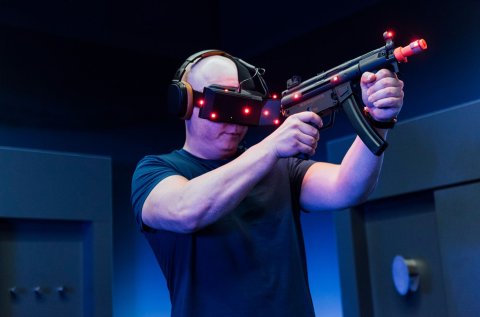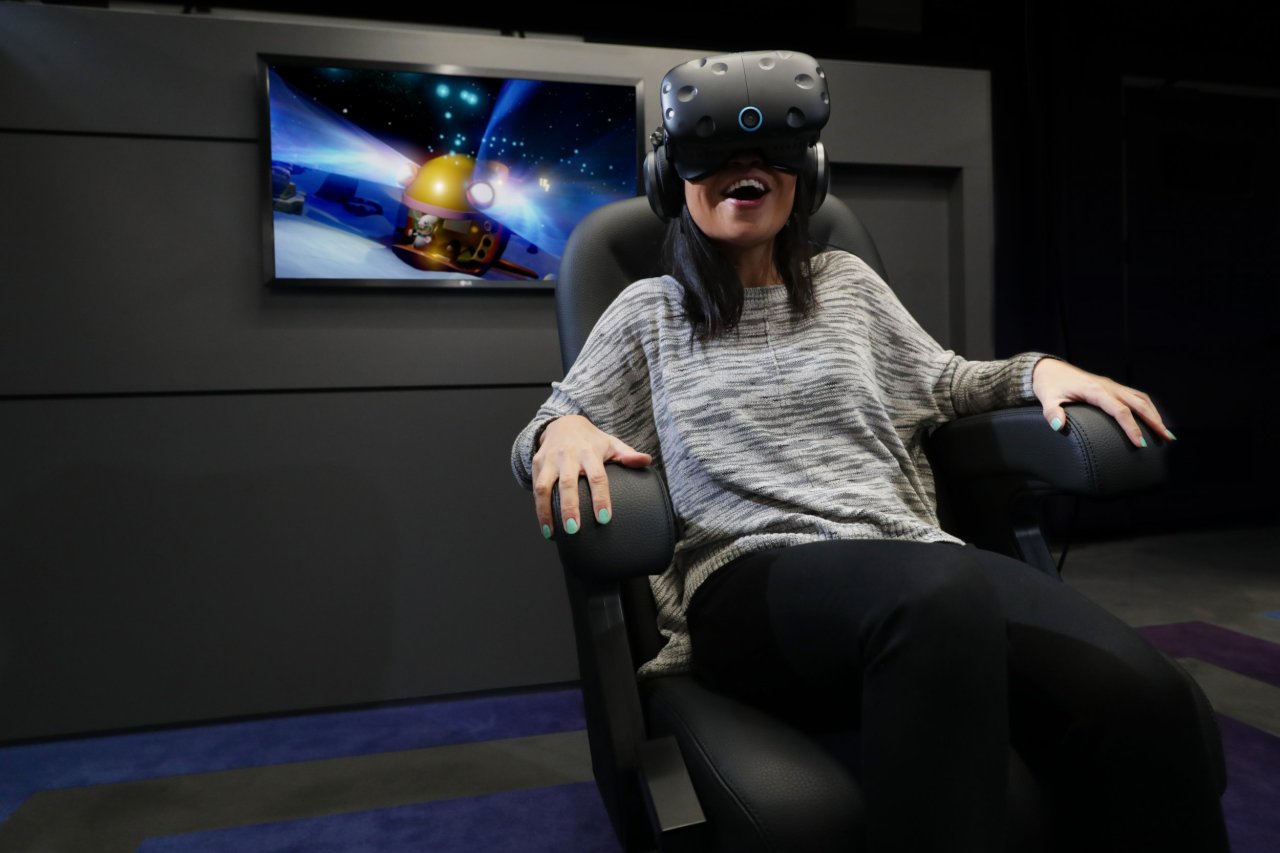Though I was born at the height of the arcade craze, I never caught Pac-Man fever. Sure, I attended a few Chuck E. Cheese parties as a kid, but by the time I hit puberty, video arcades were already GAME OVER. By the turn of the millennium, home gaming consoles like Nintendo had zapped the public amusement spaces: From 1981 to 1999, combined U.S. arcade revenues dropped from $8 billion to just over $1 billion. As Back to the Future Part II predicted in 1989, video arcades fizzled into a niche nostalgia market propped up by hipster bars. However, these days excitable nerds are once again inserting coins into public gaming spaces, at least virtually.
This isn't the first time around for VR arcades and amusement parks. Timothy Leary, the onetime "Messiah of LSD," once called VR the psychedelic of the '90s. By the mid-'90s, Sega had opened a GameWorks VR arcade in Seattle, and Iwerks Cinetropolis was a sort-of VR theme park. But the pixelated graphics of VR back then didn't look very convincing. It's not until now that virtual technology has become advanced enough to make public virtual gaming seem like a real thing.

My first sally into arcade hyperspace took place in Los Angeles's new Imax VR Experience Centre. When I got there, the exterior had been repainted to look like a retro Tetris screen. Rectangular blocks of blue and electric blue. Inside, another world. What struck me most was the astonishingly dull reality of the virtual reality arcade. Sterile lighting, corporate carpeting, shiny white walls flush with mounted flat-screens. The arcade itself was a vast warehouse space divided into 14 white 12-by-12-foot player pods. No blinking neon, à la Tron. No loud blips or bloops or high-pitched pew-pews. There were seven "immersive gaming experience" worlds that ranged in time and space from a Star Wars spaceship to Philippe Petit's famous 1974 high-wire balancing act between Manhattan's twin towers.
Like prizefighters shadowboxing in phone booths, the cubicled gamers ducked and bobbed and weaved. Some gripped toy weapons. Others shouted at apparitions only they could see. All were plugged in and decked out in Whopper-sized headphones, eyes masked by black boxes jammed with electronic ganglia reminiscent of my old VCR. Today's VR works through VR headsets. The buzz phrase is total immersion: You forget reality and start believing you're in an imaginary world.
Called HMDs (head-mounted displays) the StarVR headsets used at the L.A. arcade are panoramic, extending 210 degrees around your field of vision rather than the typical 110 degrees on living room VR headsets like Oculus Rift. Once your head is mounted, so to speak, you stare at a 3-D video screen, and technology within the device tracks your head movements. Look up and the screen scrolls up with you. Tilt left and the screen scrolls left. Rotate counterclockwise and the screen shifts like so. VR techies use airplane engineer–speak to describe these three different types of head movement: pitch, yaw and roll. But your head isn't the only thing being tracked; each Imax arcade cubicle is equipped with external cameras that monitor the positions of your entire body to make sure your movements are in sync. In the future, VR headsets will also have eye-tracking technology that ensures the closest virtual objects stay in pin-sharp focus and the ones in the distance blur.
An Imax employee hooked me up and handed me a plastic automatic version of a Heckler & Koch artillery pistol. Then I was virtually transported to the top of a building with flower beds, a swimming pool, lots of enemy fire and enough armed thugs to populate Alcatraz. All of them attempted to grapple-hook up onto my rooftop. This was a single-player shooter game based on the John Wick movies. In the virtual world, I became Keanu Reeves. But this wasn't my "red pill" moment. Instead, it felt more like a Bill and Ted adventure: Bogus!
The game world was realistic-looking, which wasn't all that pleasant. I tried to test the bounds of virtual space and accidentally smashed into a very real cubicle wall. My experience was not unlike Bill Murray's in Groundhog Day: I died over and over again. Or maybe it was more like one of the first sci-fi short stories about a simulated world, Frederik Pohl's 1955 "The Tunnel Under the World," in which the protagonist keeps waking up screaming and reliving the same day, only to discover he's being held captive to test high-tech marketing campaigns. Though I didn't earn a promotion to Level II, I somehow merited a place on the daily scoreboard.
"Bleeping sickness" was '80s slang for the dreams that came from playing too many video games. VR games can make you ill too. Some authorities on VR attribute this to clunky animation, too-slow screen refreshing, a disparity between the motion and imagery or a general glitch in the matrix. Common symptoms are disorientation, headaches and an upset stomach—sort of like when you read in a moving car or teeter-totter too hard on a catamaran. Ten minutes of John Wick left me sweating (quite a workout since I had to move my entire body, not just a joystick) and a little dizzy. At SXSW a few years ago, I nearly upchucked after trying Game of Thrones Climb the Wall VR.
John Wick VR was developed by Stockholm-based Starbreeze Studios for its StarVR headset, a gizmo that's far pricier than the Oculus Rift or PlayStation VR. Brooks Brown is Starbreeze's global director of virtual reality. He previously worked on the Avatar digital franchise and Lucasfilm web games like Lego Star Wars. He is a curious choice for a violent video game spokesman, especially one that involves shooting. "I suffer from massive PTSD," he says. "VR is being used for PTSD therapy and helps anxiety sufferers and other significant mental issues. It interacts and messes with the neurons in your brain. It puts you in a dreamlike state." Brown won't divulge what prompted his post-traumatic stress disorder, but it may have something to do with surviving the 1999 Columbine school massacre. He co-authored a book called No Easy Answers: The Truth Behind Death at Columbine High School.
The last VR game that Starbreeze produced was much scarier: Overkill's The Walking Dead. The zombie-TV-show–based game terrified players. At one point during the VR experience, someone in the unvirtual reality would grab the gamer like a zombie would in the virtual world. "People really freaked out," says Brown. "Screaming the whole time."
The Imax VR Experience Centre drew more than 15,000 visitors in its first three months of operation. A game lasts as long as 10 minutes and costs up to $10. Imax plans to open as many as 5,000 more arcades in places such as California, New York, the U.K. and Shanghai. The arcades are already a booming industry in China, where there are thousands of locations. VR arcades are opening up all across the U.S.—Indian entrepreneurs recently spent $12 million to open one, called Smaaash, in the Mall of America. Manhattan has a VR cinema-arcade, Jump Into the Light; Brooklyn has Vrba, which features 3-D painting for kids and job simulators for adult children.
Jonathan Bricklin, the co-owner (with Susan Sarandon) of SPiN Ping-Pong mecca, is opening a VR "micro-amusement park" in Las Vegas that sounds kind of like HBO's Westworld. Each VR world will have themed lighting and props in real life to complement whatever you're watching on the VR goggles. "A killing world, where you could play first-person shooter games or military war games," says Bricklin. "First-person shooter games are the most popular, but they're not really my favorite. I refer to them as killing. A Transportation World where you could play racing or flying games, a Sports World, a Carnival World for harder-to-categorize VR novelty experiences like this Skee-Ball game I love and a provocative Red Light District for a carefully curated selection of porn and virtual strippers. We want to market Red Light as a fun group experience for Vegas bachelor or bachelorette parties." Bricklin won't know the final themes until he has "specific content." Some virtual worlds are still quite virtual.
Gaming isn't the only purpose of VR in public spaces. It's become a trend at lots of movie theaters and museums. You can now spend six minutes hanging out with virtual sea turtles and 80-foot virtual blue whales at the Los Angeles County Natural History Museum exhibit "theBlu: An Underwater VR Experience." The most dizzying arcade of all may be the immersive dot simulations of the "Yayoi Kusama: Infinity Mirrors" exhibits at the Hirshhorn Museum and Sculpture Garden in Washington, D.C. Known for her fascination with polka dots, Kusama is one of the dottiest Japanese artists working today, and, for that matter, the world. Since it opened February 23, the museum's show featuring the Japanese painter and sculptor has been consistently sold out.
The Hirshhorn's in-house app designers partnered with Samsung to fashion a VR experience for the new exhibition. There are VR experiences for three of the exhibit's six Infinity Mirror Rooms—enclosed chamber installations you enter to be surrounded by "infinity" optical illusions created by polka dots, mirrors, LEDs and sculptures. "Phalli's Field" Infinity Mirror Room has more red and white dots than a Target store. The rhinoceros-sized pink spheres of "Dots Obsession—Love Transformed Into Dots" look like ladybugs while you're tripping on acid. "All the Eternal Love I Have for the Pumpkins" is a dark, endless field of glowing mutant gourds. (The VR app was developed to accommodate people with mobility issues since the chambers have ramp entryways that are too narrow for large wheelchairs.) Six years ago, Kusama said that her Mirror Rooms "give us the sense of the infinite existence of electronic polka dots." How infinitely prophetic.
Digital dreamworlds are shifting from fantasy into reality. Lest you get the idea that virtual reality arcades are just harmless fun and games, consider the cautionary note sounded by William Gibson, the writer who dreamed up the concept of cyberspace in Neuromancer, his balefully prophetic 1984 novel. Gibson preached about the inherent dangers of the nascent technology. "It could be lethal," he wrote. "It's like freebasing American television."
















